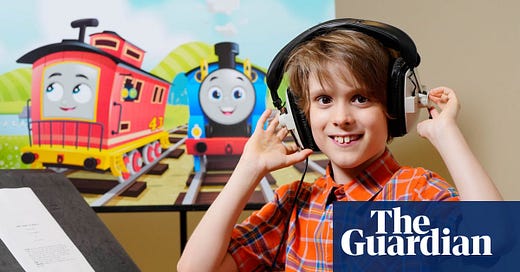Borkowski Weekly Media Trends 16-09-22
Chalamet Vogue Cover | ETH Merge | LOTR vs Simpsons vs Peppa vs Thomas: Classics in Progressive Arms Race
Vogue’s Male Cover Divides Opinion
Edward Enninful, the fashion industry darling and editor-in-chief of British Vogue has come out with a new hit. For the first time in history, the British edition of the magazine features a man on its print cover, a man no other than Timothee Chalamet himself.
The photoshoot and the interview promote Chalamet’s new film, Bones and All, and the editorial’s grungy aesthetic is inspired by the film’s plot, a cannibalistic coming-of-age romance. In a YouTube video of Enninful casually interviewing Chalamet to accompany the issue, Enninful makes a somewhat baffling statement: ‘We are a women’s magazine, so to have a guy be in it it’s always like the fantasy, you know?’.
Men on the cover of Vogue are not exactly unheard of – many countries have their own Vogue men’s magazine which focus on menswear and interviews with male celebrities. We also have the Harry Styles American Vogue cover, which aimed to break the internet but was quite poorly received (facing the inevitable accusations of queerbaiting but also of being accused of being fashion-deficient). It would be cynical to say men are barred from the fashion industry – it is in fact almost entirely run by male designers, agents, and photographers. Fashion journalism is really one of the only professions in this industry that has been dominated by women. This is also one of the reasons why Enninful’s appointment as editor-in-chief was so newsworthy – he is the first man to take such role at Vogue. And, having that knowledge, it is especially bizarre for him to frame Chalamet’s cover as a crucial example of representation, stuff of wildest dreams.
The choice of Chalamet, as it was with Styles, it purely tactical. They are men, yes, but they are also widely acclaimed, mildly androgynous heartthrobs. It is ultimately still about exciting the straight female audience: if you cannot give them female models to look at, a handsome twenty-something actor is a close second. Publicity-wise, it’s not that ground-breaking. Visually, it’s a little boring. But needed representation it is not, and pushing this argument is not bound to gain Enninful any more fans.
ETH Merge doesn’t hit Jackpot
If you’ve seen it mentioned with context, no, ‘The Merge’ is not the name of a new thriller or horror. Although 41,000 people did join a YouTube live viewing party for it. It’s blockchain Ethereum, moving away from its previous energy intensive ‘validation mechanism’ (proof of work) to a new more sustainable and efficient path for the future with a new ‘proof of stake’ system.
Ethereum has become the second largest blockchain and the platform for many blockchain based applications such as NFTs, and decentralised finance.
The merge has reduce the energy consumption of the Ethereum blockchain by over 99% overnight, equivalent to a small modern country shutting down. Or 0.2% of world energy output.
The price of ETH, the second largest cryptocurrency after bitcoin was largely flat after the Merge, a disappointment to many who thought this would be the “to the moon” moment.
You might be wondering how is this significant? Apart from it being one of the largest open-source software developments in history it means Ethereum has drastically cut its environmental footprint, opening up its blockchain to a whole new userbase, to grow further.
For now, it’s secured its space as a leading blockchain, and a practical one at that. There are still many challenges to come from high transaction fees - or Gas fees as they are called- to the slow speeds but they have proven they could deliver the merge, so who knows…maybe despite the underwhelming short term impact, long term ETH is unstoppable.
Traditional finance, and big tech will be watching closely as this new open sourced movement poses a growing threat day by day.
TV Classics in Progressive Arms Race
Seeding progressive (some would say ‘woke’ values) into film and television properties in the hope of courting a forward-thinking audience is nothing new, but the last week or so has seen the trend kick into overdrive.
This can be a fraught process for global entities, as Disney experienced when criticised for crow-barring a same sex kiss into their live action Beauty and the Beast before editing the scene out in certain territories.
The culture wars were in overdrive already as ‘not racist but…’ fantasy fans got their knickers in a twist about the depiction of black hobbits and elves in Amazon’s Tolkien blockbuster Rings of Power, unbothered by the fact that mythological creatures don’t necessarily have a ‘race’, and even less bothered about what have long been thought to be racist tropes in the source material.
Thomas the Tank engine then announced their effort to champion neurodiversity by introducing an autistic character.
Hot on their heels Peppa Pig introduced a same sex couple of Polar Bear mums – its first explicitly LGBTQ characters. Not to be outdone, The Simpsons, whose ‘cancellation’ of Apu – an Indian character voiced by a white man- was a catalyst in this progressive arms race, depicted a (non-canonical it is thought) future Lisa with a female partner.
Whether these are publicity stunts, cynical woke-signalling, or simply an earnest attempt to reflect modern society the reaction is generally the same; mild if not ecstatic approval from the liberal-moderate majority, disdain ranging to unhinged outrage from everyone else. It’s a reliable news generator, but in an age where such moves are ten-a-penny, it’s hardly a revolutionary tactic.





